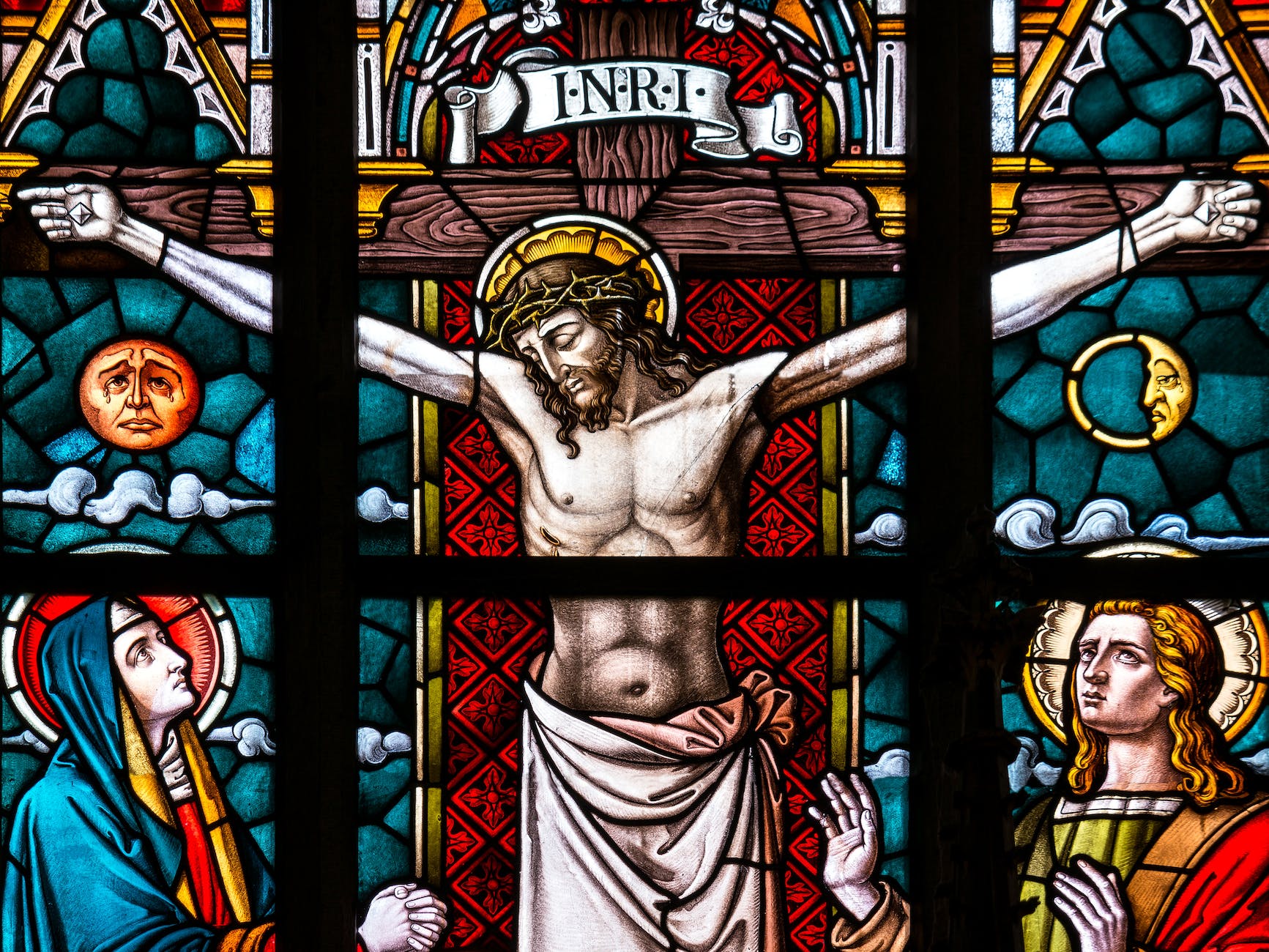A man I didn’t know but was acquainted with recently passed away after a brief illness. I was told of his death and informed, sadly, that he was an atheist. He didn’t believe in God. He didn’t believe in any higher authority. My response was, “Well, he’s a believer now.”

Imagine living your life, rebuking any notion of God as Creator, Jesus as a Savior, the Holy Spirit as a Helper, and discovering that it was true all along. Think about how overwhelming it would be to discover that Abraham was a real person and he had been willing to sacrifice his son, Isaac, at the order given by God. The shock of realizing there really had been a man named Noah who built an ark that saved only those onboard from a flood that covered the Earth. How incomprehensible it would be that a virgin had truly become pregnant, not by normal methods or medical intervention, but by miraculous conception. And last, but certainly not least, that a man who was God wrapped in human flesh, had endured a brutal beating, public humiliation, and a tortuous death some 2,000 years ago and… most unbelievable of all, He did that for you.
An atheist who is confronted with the reality of all that is written in God’s Word would have to be, I believe, astounded at the truth of it all. I can’t help but wonder if the atheist would be overwhelmed by a tsunami of emotions: guilt, grief, humbleness, helplessness, shame, sadness, remorse, and regret. To see the scars Jesus bears because He chose to suffer and die on our behalf.
Yes, on our behalf.
If you had to guess how many times you’ve heard about the crucifixion in your lifetime, what would you say? 50 times? 100 times? 1,000 times? Those of us who were raised in the church most likely wouldn’t even begin to estimate how often we’ve heard about or sung about Jesus dying on the cross. Certainly, every Palm Sunday and every Easter Sunday, the main central theme is the crucifixion. Our hymns that we sing and hum all year long make reference to the cross and to the sacrifice Jesus made.
The Old Rugged Cross by George Bennard
“On a hill far away, stood an old rugged Cross
The emblem of suffering and shame
And I love that old Cross where the dearest and best
For a world of lost sinners was slain”
When I Survey the Wondrous Cross by Isaac Watts
“See from His head His hands His feet
Sorrow and love flow mingled down
Did e’er such love and sorrow meet
Or thorns compose so rich a crown”
Jesus Paid it All by Elvina M. Hall
“Jesus paid it all,
All to Him I owe;
Sin had left a crimson stain,
He washed it white as snow.”
At the Cross by Isaac Watts
” Alas, and did my Savior bleed?
And did my Sovereign die?
Would He devote that sacred head
For such a worm as I?
Was it for sins that I had done
He groaned upon the tree?
Amazing pity! grace unknown!
And love beyond degree!”

The cross is a symbol that is just as familiar to the entire population as the heart, smiley face, and peace sign. When people see the cross symbol, what do they think? Usually, the cross conjures up thoughts of Christianity or faith. We frequently see crosses. We wear it as jewelry. We more than likely have at least one cross in our home. Cemeteries are dotted with crosses carved into or out of stone. We see crosses on church steeples, as well as inside the church. Crosses are frequently seen throughout our normal daily functions. As such, we run the risk of becoming complacent about what the cross should stir up within us.
Oswald Chambers said, “All heaven is interested in the cross of Christ, all hell terribly afraid of it, while men are the only beings who more or less ignore its meaning.”
Have we heard this story, this historical event so many times that we’ve become desensitized to it? Have we, over time, minimized the brutality, injustice, viciousness, and cruelty Jesus endured for such worms as us?
Let us take a step back from the familiarity of this story and really examine, as best as we can, what Jesus endured. I do want to warn you that some of this content is graphic. It’s sickening and it’s hard to hear and picture. It will likely make you wince and feel uncomfortable. But as uncomfortable as you may become listening to it, think about how much more uncomfortable it was to physically go through it.
John 19:1 NLT “Then Pilate had Jesus flogged with a lead-tipped whip. 2 The soldiers wove a crown of thorns and put it on his head, and they put a purple robe on him. 3 “Hail! King of the Jews!” they mocked, as they slapped him across the face.”
In these three verses, five separate things are done to Jesus in an attempt to torture and humiliate Him.

First the flogging. Flogging was done with a whip. Scripture specifies “a lead-tipped whip”. It is possible and likely that there would be multiple leather straps, each strap “embedded with chunks of bone, leather, or hooks. The point was to tear up the victim. Romans hoped the gore would discourage onlookers from breaking the law. Writers who witnessed crucifixions in Jesus’ day said they saw lashes rip open skin and muscle, exposing the victims bones and intestines. Some victims never made it to the cross, they died at the beating. ” [i]
Here is a medical explanation of what would normally take place in a flogging.
“When the whips would strike the flesh, instead of leaving a nice, clean laceration they would dig into the flesh and stay. The flogger would then have to pull the whips out, which tore chunks of flesh off with it. The whip lashes that you normally think of are not what is produced here. Whole sections of flesh are torn off. After several blows, the back would be so shredded that parts of the spine may be exposed. The lacerations would tear into the underlying skeletal muscles and produce quivering ribbons of bleeding flesh…
The sufferer’s veins were laid bare, and the very muscles, sinews, and bowels of the victim were open to exposure. The whippings go from the shoulders, down the back, the buttocks and to the upper part of the legs.
Many people died from this kind of beating even before they were crucified. At the very least, the person would experience tremendous pain and go into hypovolemic shock.
Hypovolemic shock does four things to a person:
1. the heart races to try to pump blood that isn’t there
2. the blood pressure drops, causing fainting or collapse
3. the kidneys stop producing urine to maintain what volume is left
4. the person becomes very thirsty as the body craves fluids to replace the lost blood volume”[ii]
Interestingly, Jewish law set limits on flogging, but for a strange reason. Deuteronomy 25:2b GNT “The number of lashes will depend on the crime he has committed. 3 He may be given as many as forty lashes, but no more; more than that would humiliate him publicly.” It’s baffling that 40 lashes wouldn’t be humiliating, but 41 lashes would be. Often, only 39 lashes would be administered in case someone miscounted and they certainly didn’t want to run the risk of humiliating the person with that one extra lash. (Sarcasm intended.)
Movies often depict Jesus receiving 39 lashes; however, we don’t really know how many He would have received. The 39-lash limit was Jewish law. The floggers in Jesus’ case were Romans who didn’t adhere to Jewish law, so it’s possible that Jesus received even more than the limited 39.


Next was the crown of thorns. The main objection by the Roman soldiers in fashioning this crude crown was for mockery and humiliation. The fact that it was made of a vine of thorns just adds to the cruelty. If you’ve ever been pricked by a thorn, you know it hurts. Most of us have probably experienced the pain of thorns on a rose bush, holly bush, or cactus plant. Those thorns are usually quite small and so it’s a lot like a needle prick. It hurts and the area may be sore for a bit, but being pricked by a thorn such as this wouldn’t be debilitating.
However, it is believed that the crown of thorns was most likely formed from a date palm. The reason is this. We know that there are no coincidences when it comes to God. Merely days earlier, palm branches were used in a very different way. John 12:13 NIV “They took palm branches and went out to meet him, shouting,
“Hosanna!]”
“Blessed is he who comes in the name of the Lord!”
“Blessed is the king of Israel!”

And then, within a week’s time, those who had cried “Hosanna” and “Blessed is He”, just days later, shouted “Crucify Him!” The palm branches that had symbolized joy and victory with the arrival of Jesus were long forgotten. The Roman soldiers, looking for a means to further humiliate and torture Jesus may very well have thought it humorously ironic to use thorns from the very same trees that the branches had been taken. What once was used to honor Jesus would now be used to inflict great pain on Him.
The “spikes {of date palm trees} were very thick and very hard, growing up to twelve inches long in some cases.
Medically, the thorns of a date palm are known to possess toxins that can cause, in addition to, excruciating pain, inflammation, bruising, and tissue damage.”[iii]
It is presumed that the soldiers didn’t merely place the crown of thorns on His head but actually pressed the thorns into His flesh causing more pain and more wounds.
They put on Him a purple robe. Purple, of course, is a color symbolic of royalty. The dye that was used to make the purple came from a small mollusk that was only in a certain region. It would take 9,000 mollusks to make just one gram of the dye which obviously made it rare and extremely expensive. [iv] Therefore, few people could afford to wear any clothing made with it. The Roman soldiers certainly were not trying to pamper Jesus or demonstrate their allegiance or affection towards Him with the purple robe. Instead, they intended to mock the claim that Jesus was king.
The purple robe may seem harmless if you ignore the sarcasm behind it. But if you think about the wounds Jesus would have had from the flogging and the amount of blood that would have been pouring out. Then this robe is placed on top of those wounds. No ointment. Nothing to prevent the coagulated blood to become attached to the fibers of the robe. Then when the robe is ripped off, further pain would have been inflicted.
Then they mocked Him and slapped Him across the face.
If any one of those things would have happened to us, it would be memorable. A severe beating to the point of being close to death. Being impaled in our head by a twisted vine of long, sharp thorns. As far as the robe being ripped from our open wounds, let’s face it. Most of us can hardly stand to rip a Band-Aid from our arm. A slap in the face, whether done physically or metaphorically is devastating. There is a level of insult that is intended. A slap in the face is done to disrespect. Mocked. Maybe you’ve experienced this. Maybe you’ve been the object of public humiliation. It’s hurtful. The emotional scars from being mocked are deep and never really heal.
Jesus experienced all of these. Not for His own actions, but for yours and mine.
John 19:16 NLT “Then Pilate turned Jesus over to them to be crucified. So they took Jesus away. 17 Carrying the cross by himself, he went to the place called Place of the Skull (in Hebrew, Golgotha)”
It is believed that the distance Jesus had to travel from the place of His flogging to Golgotha (or Calvary) was at least 1/3 of a mile.[v] That would have been approximately 716 steps that Jesus took.[vi] After the nearly fatal beating, the loss of blood, and the shock that His physical body would have experienced would have made the journey nearly impossible. Although we usually see depictions of Jesus carrying the entire cross, this may not have been what actually happened. Normally, the vertical piece of the cross would have already been standing and the person would have had to carry the crossbar. However, it could be that Jesus was forced to carry the entire cross. There were certainly exceptions made, not for His benefit, but rather for His torture.

Even if He had carried just the horizontal beam, it’s estimated that it would have weighed between 70-90 pounds.[vii] It was too much. His physical body was giving out. A man by the name of Simon from Cyrene just happened to be in the crowd and he was solicited to carry the cross for Jesus when it became too much. Luke 23:26 NASB “And when they led Him away, they seized a man, Simon of Cyrene, as he was coming in from the country, and placed on him the cross to carry behind Jesus.”
Simon doesn’t volunteer to help Jesus, but he also doesn’t resist when he is compelled to help. He carries the cross behind Jesus which is quite symbolic of our lives as Christians and how that was designed. Matthew 16:24 NIV “Then Jesus said to his disciples, “Whoever wants to be my disciple must deny themselves and take up their cross and follow me.” The burden of the weight of the cross, the view of Jesus and His weakened and beaten body barely able to take steps in front of him, the taunts, and the insults from the mob in this morbid parade would have made this difficult for Simon. But it was necessary.
I discovered this sweet legend regarding Simon of Cyrene. “Legend tells us that Simon of Cyrene, the man who helped Jesus carry his cross up to Calvary, was an egg merchant. Passing by on his way to market, Simon is stopped by Roman soldiers and ordered to help Jesus carry his cross to Calvary. Three days later, Simon rejoices when he sees that not only has Jesus risen from the dead but his eggs have been transformed into a colorful new gift from Jesus-the first Easter eggs!”[viii]

Then came the crucifixion. “Romans mainly reserved the prolonged and painful method of execution by crucifixion for slaves, but they also sometimes used it for revolutionaries (like Jesus), foreigners, criminals, military deserters and other outcasts.”[ix]
John 19:18 NLT “There they nailed him to the cross.”
Such a simple sentence but the pain and the injury was far from simple.
“The Romans used spikes that were 5 to 7 inches long and were tapered to a fine point. They were usually driven through the wrist, not the hand. The wrist was considered part of the hand in Roman times. If the spikes were driven through His palms, His weight on the cross would have caused the skin to tear and He would have fallen off of the cross. A spike through the wrist would have hit and crushed the median nerve. This type of pain was so beyond description that a new word was invented to describe it – excruciating – which literally means ‘out of the cross’.”[x]
The same kind of pain would have been felt by the piercing of His feet. His arms would have been stretched out “about 6′ in length and both shoulders would have become dislocated.
As the arms fatigue, great waves of cramps sweep across the muscles, knotting them in deep, relentless, throbbing pain. Hanging by His arms, the pectoral muscles become
paralyzed and the intercostal muscles are unable to act…”
” Crucifixion is death by asphyxiation. In order to exhale, Jesus had to push up on His feet so the tension on His diaphragm muscles would be eased for a moment. But, by doing this, His foot pushed through the spike, locking up against the tarsal bone, creating incredible amounts of pain. Also, He was scrapping His bloodied back against the coarse wood of the cross. After exhaling, He was able to relax and take another breath in. But again, He’d have to push Himself up to exhale. All of this just for one breath. This would go on until the person wasn’t able to push up to breathe anymore…
As Jesus slows down His breathing, He goes into respiratory acidosis. The carbon dioxide in His blood is dissolved into carbonic acid, causing the acidity of His blood to rise. This leads to an irregular heartbeat. In addition to that, the hypovolemic shock would have caused an increased heart rate that contributed to heart failure resulting in pericardial effusion (fluid around the heart) as well as pleural effusion (fluid in the lungs). It is almost over now…
The loss of tissue fluid has reached a critical level; the compressed heart is struggling to pump heavy, thick, sluggish blood into the tissues, and the tortured lungs are making a frantic effort to gasp in small gulps of air, while the markedly dehydrated tissues send their flood of stimuli to the brain. Once feeling in the legs was gone, Jesus would be unable to push up in order to breathe and death would occur quickly…
When the Roman soldier’s spear went through His side (John 19: 34), blood and water came out This is exactly what would happen if the spear ruptured the heart. The blood and ‘water’
would be separated because of pericardial effusion.” Medically speaking, there is no doubt… Jesus was dead!” [xi]
To add insult to injury, as Jesus took His last breath, only one of His apostles, only one of His closest friends was there. The others had scattered out of fear for their own lives. In His darkest hour, Jesus had been abandoned by those who claimed to know and love Him the most.
Jesus was dead because of you and because of me.
Jesus had to suffer like He did because we lie, we lust, we steal, we are selfish. Jesus had to endure the excruciating pain because we are prideful, we pretend to be something we aren’t. We are gluttonous, we are guilty. We worship idols, we whine and complain about the most insignificant things. Jesus had to die because we don’t forgive and we don’t forsake others. We cheat, we cuss. We are lazy and we don’t love as we should. Jesus was dead because, on our own, we can do nothing to deserve what He has in store for us.
2 Corinthians 5:21 NLT “For God made Christ, who never sinned, to be the offering for our sin, so that we could be made right with God through Christ.”
The cross is so much more than just a symbol. The cross is the core of our faith. It’s the foundation of our relationship with God. Without the cross, there is no forgiveness, there is no eternity, there is no hope. John R.W. Stott said, “There is no Christianity without the cross. If the cross is not central to our religion, ours is not the religion of Jesus.”
Every week we gather to study God’s Word and we use those lessons and discussions to make applications to our lives. But the application is weakened when we don’t fully grasp the sacrifice Jesus made for us individually.
Don’t minimize what Jesus went through for you. Don’t forget the excruciating pain He endured. Don’t reduce the cross to a piece of jewelry or symbol. Instead, let it be a painful but joyful reminder of the depths of love He has FOR you and wants FROM you.
Let’s end on a good note: I later found out that the acquaintance who recently passed away accepted Jesus into his heart shortly before he died. I thanked God that although this man had lived decades resisting a relationship with his Creator, what mattered was where he was spending eternity and, most importantly, THE ONE he was spending it with.
[i] Understanding Jesus, A Guide to His Life and Times, Stephen M. Miller
[ii] https://bsssb-llc.com/medical-description-of-the-flogging-and-crucifixion-of-jesus/
[iii] https://www.christianity.com/wiki/holidays/what-is-the-significance-of-the-crown-of-thorns.html
[iv] https://christianity.stackexchange.com/questions/41580/what-is-the-significance-of-colour-purple-in-the-robe-that-jesus-was-made-to-wea
[v] https://understandingthebible.org/how-far-did-jesus-carry-the-cross/#:~:text=Jesus%20%28and%20Simon%20of%20Cyrene%29%20carried%20His%20cross,and%20then%20lead%20to%20Golgotha%20to%20be%20crucified.
[vi] https://www.thecalculatorsite.com/health/miles-steps.php
[vii] https://www.biblword.net/what-is-the-weight-of-the-cross-that-jesus-carried/#:~:text=It%20is%20believed%20to%20have%20been%20made%20of,to%20be%20around%2070%20-90%20pounds%20%2832-41%20kilograms%29.
[viii] https://www.catholiccompany.com/simon-of-cyrene-and-legend-of-easter-egg-i133163/
[ix]https://www.history.com/news/jesus-christ-death-crucifixion-archaeology
[x] https://bsssb-llc.com/medical-description-of-the-flogging-and-crucifixion-of-jesus/
[xi] https://bsssb-llc.com/medical-description-of-the-flogging-and-crucifixion-of-jesus/